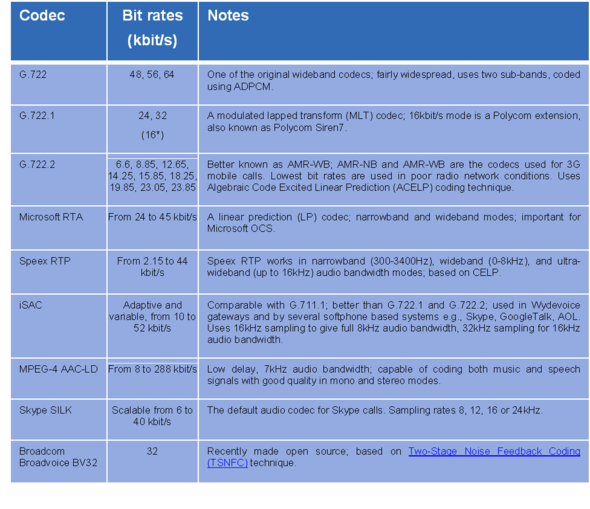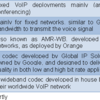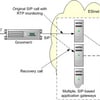In the second part in my series of articles on HD Voice, I discuss the wideband codecs currently available and deployed, and suggest which might be the best choices for a wideband voice platform. Part 1 in this series discussed the question of how much bandwidth do you need for voice solutions.
Wideband (up to 8kHz audio bandwidth) codecs currently available and deployed include:

Other interesting wideband codecs currently available but not yet widely deployed are the embedded codecs G.711.1 and G.729.1. These codecs, as their name implies, are meant to operate as extensions of existing narrowband codecs. The idea behind them is that they can operate in both narrowband and wideband modes. They use separate parts to encode the narrowband voice, and additional bits to convey the higher frequencies, up to 7kHz. They support 'on-the-fly' bit rate selection, thus making them ideal for situations when mixed narrowband and wideband capability is needed. By having a single codec that can work in both narrowband and wideband modes, transcoding (and all the issues it creates) is avoided.
The most common wideband codecs currently deployed in communications platforms and supported by widely available endpoints are the original G.722 codec (standardised in the 1980s), the G.722.2 (AMR-WB codec) used in mobile applications, and codecs such as iSAC from GIPS, or Skype's SILK.

Other interesting wideband codecs currently available but not yet widely deployed are the embedded codecs G.711.1 and G.729.1. These codecs, as their name implies, are meant to operate as extensions of existing narrowband codecs. The idea behind them is that they can operate in both narrowband and wideband modes. They use separate parts to encode the narrowband voice, and additional bits to convey the higher frequencies, up to 7kHz. They support 'on-the-fly' bit rate selection, thus making them ideal for situations when mixed narrowband and wideband capability is needed. By having a single codec that can work in both narrowband and wideband modes, transcoding (and all the issues it creates) is avoided.
The most common wideband codecs currently deployed in communications platforms and supported by widely available endpoints are the original G.722 codec (standardised in the 1980s), the G.722.2 (AMR-WB codec) used in mobile applications, and codecs such as iSAC from GIPS, or Skype's SILK.
G.722
A mature standard and now licence free as its patents have expired. G.722 support appears in most, if not all, SIP-based desk phones and soft phone applications.
Its deployment is widespread; some of the larger deployments to date are:
- British Telecom - available on BT Home Hub ADSL device but users are typically unaware it is 'HD'
- France Telecom - supported on FT's broadband home networking device; over 500k users
- 8x8 - more than 70,000 G.722 users
- Ooma - 25,000 G.722 users
A full list can be found on the HD Voice News site, an excellent resource provided by Doug Mohney.
AMR-WB (G.722.2)
Third generation (3G) mobile networks use adaptive multi-rate (AMR) codecs as they are able to adjust as required to the vagaries of a radio based communications network. Currently the narrowband version of AMR is deployed, with just a few instances (mainly from the France Telecom/Orange group) where AMR-WB is being added to both network and mobile phone capabilities.
The standard was developed for use in mobile networks, however, it does not have to be limited to that application. If one considers the trend of voice minutes shifting from fixed to mobile, then perhaps AMR-WB might become the most widely used wideband codec in the near future. If fixed applications also used the same codec, then networks would not have to be engineered to transcode between AMR-WB and another wideband codec. The penalty with this approach for developers of fixed solutions is the small licensing fee that applies to the use of AMR-WB.
iSAC
A codec developed by Global IP Solutions (GIPS) and designed to deliver wideband sound quality in both low and high bit rate applications. It has been used in several softphone clients such as Skype, Yahoo! and AOL. iSAC is also available for use in hardware clients, one example being the Wydevoice VM1000/3000 bridges that support iSAC via the Aculab Prosody X enabling technology embedded within them.
SILK
SILK is one of the codecs used in the Skype softphone application from version 4 onwards. One reason to consider SILK is that Skype claims over 20 million deployments of its application, hence giving it one of the largest deployment footprints of any wideband capable platform today. Another important reason to consider the SILK codec is that Skype has made it royalty free and has submitted it for approval as a standard to the Internet Engineering Task Force (IETF).
For a provider of communications platform enabling technology such as Aculab, the key when considering which features to include for our customers developing HD Voice enabled platforms is flexibility:
AMR-WB (G.722.2)
Third generation (3G) mobile networks use adaptive multi-rate (AMR) codecs as they are able to adjust as required to the vagaries of a radio based communications network. Currently the narrowband version of AMR is deployed, with just a few instances (mainly from the France Telecom/Orange group) where AMR-WB is being added to both network and mobile phone capabilities.
The standard was developed for use in mobile networks, however, it does not have to be limited to that application. If one considers the trend of voice minutes shifting from fixed to mobile, then perhaps AMR-WB might become the most widely used wideband codec in the near future. If fixed applications also used the same codec, then networks would not have to be engineered to transcode between AMR-WB and another wideband codec. The penalty with this approach for developers of fixed solutions is the small licensing fee that applies to the use of AMR-WB.
iSAC
A codec developed by Global IP Solutions (GIPS) and designed to deliver wideband sound quality in both low and high bit rate applications. It has been used in several softphone clients such as Skype, Yahoo! and AOL. iSAC is also available for use in hardware clients, one example being the Wydevoice VM1000/3000 bridges that support iSAC via the Aculab Prosody X enabling technology embedded within them.
SILK
SILK is one of the codecs used in the Skype softphone application from version 4 onwards. One reason to consider SILK is that Skype claims over 20 million deployments of its application, hence giving it one of the largest deployment footprints of any wideband capable platform today. Another important reason to consider the SILK codec is that Skype has made it royalty free and has submitted it for approval as a standard to the Internet Engineering Task Force (IETF).
For a provider of communications platform enabling technology such as Aculab, the key when considering which features to include for our customers developing HD Voice enabled platforms is flexibility:
- If a core network platform only supports one wideband codec, then it is limited in terms of the endpoints that it can support
- To enable wideband endpoints with different wideband codecs to talk to each other, a core platform has to provide transcoding facilities (ideally the endpoints would support more than one wideband codec so they could negotiate the call using a wideband codec they had in common)
When we recently added the G.722 codec to the Aculab Prosody X and Prosody S media processing platforms due to customer demand, I also made sure at that time to recommend adding other wideband codecs (G.722.1 , licensed by Polycom and G.722.2 a.k.a. AMR-WB) so that our customers had a good choice for wideband voice communications. The Prosody X and Prosody S platforms now support some of the most widely deployed wideband codecs, and we are not stopping there - we have others in the pipeline. Watch our website for announcements.
About me
Andrew Nicholson is a Product Manager at Aculab responsible for the Prosody X and Prosody S media processing products. You can contact me here. Alternatively, follow Aculab using our Twitter account.




 Technorati
Technorati Del.icio.us
Del.icio.us Slashdot
Slashdot Digg
Digg twitter
twitter


























Stumbled into this site by chance but I’m sure glad I clicked on that link. You definitely answered all the questions I’ve been dying to answer for some time now. Will definitely come back for more of this. Thank you so much